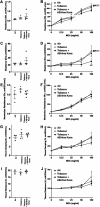Flavokavains A- and B-Free Kava Enhances Resilience against the Adverse Health Effects of Tobacco Smoke in Mice
- PMID: 39539272
- PMCID: PMC11555507
- DOI: 10.1021/acsptsci.4c00415
Flavokavains A- and B-Free Kava Enhances Resilience against the Adverse Health Effects of Tobacco Smoke in Mice
Abstract
Tobacco smoke remains a serious global issue, resulting in serious health complications, contributing to the onset of numerous preventive diseases and imposing significant health burdens. Despite regulatory policies and cessation measures aimed at curbing its usage, novel interventions are urgently needed for effective damage reduction. Our preclinical and pilot clinical studies showed that AB-free kava has the potential to reduce tobacco-smoking-induced lung cancer risk, mitigate tobacco dependence, and reduce tobacco use. To understand the scope of its benefits in damage reduction and potential limitations, this study evaluated the effects of AB-free kava on a panel of health indicators in mice exposed to 2-4 weeks of daily tobacco smoke exposure. Our assessments included global transcriptional profiling of the lung and liver tissues, analysis of lung inflammation, evaluation of lung function, exploration of tobacco nicotine withdrawal, and characterization of the causal protein kinase A (PKA) signaling pathway. As expected, tobacco smoke exposure perturbed a wide range of biological processes and compromised multiple functions in mice. Remarkably, AB-free kava demonstrated the ability to globally mitigate tobacco smoke-induced deficits at the molecular and functional levels with promising safety profiles, offering AB-free kava unique promise to mitigate tobacco smoke-related health damages. Further preclinical evaluations are warranted to fully harness the potential of AB-free kava in combating tobacco smoke-related harms in the preparation of its clinical translation.
© 2024 American Chemical Society.
Conflict of interest statement
The authors declare the following competing financial interest(s): The authors declare the following competing nancial interest(s): the AB-free kava product evaluated is based on the IPs owned by Kuality Herbceutics (KH). There is no profit or product from KH yet. Chengguo Xing has 55% ownship of KH. He also provides consultation to KH for its strategy on development. All other authors declare no conicts of interest.
Figures







Update of
-
AB-free kava enhances resilience against the adverse health effects of tobacco smoke in mice.bioRxiv [Preprint]. 2024 Jun 29:2024.06.25.599576. doi: 10.1101/2024.06.25.599576. bioRxiv. 2024. Update in: ACS Pharmacol Transl Sci. 2024 Oct 02;7(11):3502-3517. doi: 10.1021/acsptsci.4c00415. PMID: 38979295 Free PMC article. Updated. Preprint.
References
Grants and funding
LinkOut - more resources
Full Text Sources
Molecular Biology Databases
Research Materials
